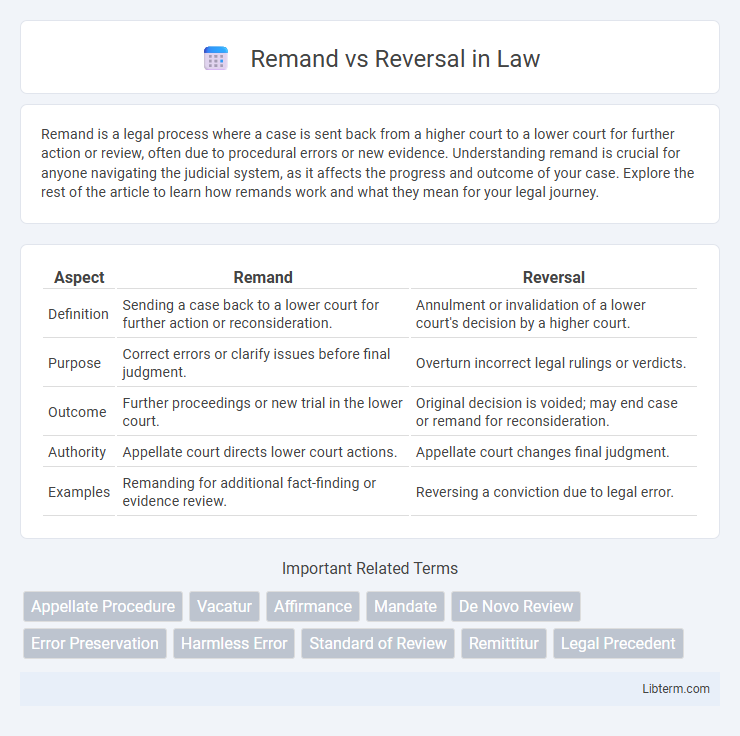Remand is a legal process where a case is sent back from a higher court to a lower court for further action or review, often due to procedural errors or new evidence. Understanding remand is crucial for anyone navigating the judicial system, as it affects the progress and outcome of your case. Explore the rest of the article to learn how remands work and what they mean for your legal journey.
Table of Comparison
| Aspect | Remand | Reversal |
|---|---|---|
| Definition | Sending a case back to a lower court for further action or reconsideration. | Annulment or invalidation of a lower court's decision by a higher court. |
| Purpose | Correct errors or clarify issues before final judgment. | Overturn incorrect legal rulings or verdicts. |
| Outcome | Further proceedings or new trial in the lower court. | Original decision is voided; may end case or remand for reconsideration. |
| Authority | Appellate court directs lower court actions. | Appellate court changes final judgment. |
| Examples | Remanding for additional fact-finding or evidence review. | Reversing a conviction due to legal error. |
Understanding Remand and Reversal
Remand occurs when an appellate court sends a case back to the lower court for further action consistent with its ruling, often to correct errors or conduct a new trial. Reversal involves the appellate court overturning the lower court's decision, effectively nullifying the original judgment. Understanding remand and reversal is crucial for grasping appellate procedures and their impact on case outcomes.
Key Legal Definitions
Remand refers to a higher court sending a case back to a lower court for further action consistent with the appellate court's findings. Reversal occurs when an appellate court overturns the lower court's decision entirely, rendering the original judgment null and void. These key legal definitions highlight distinct judicial remedies impacting case outcomes and procedural posture.
Differences Between Remand and Reversal
Remand refers to a higher court sending a case back to a lower court for further action or reconsideration, while reversal means the higher court overturns the lower court's decision entirely. A remand requires additional proceedings based on specific instructions, whereas a reversal results in a final change of the original judgment. The key difference lies in remand preserving the lower court's involvement, while reversal terminates it by altering the case outcome.
The Remand Process Explained
The remand process occurs when an appellate court sends a case back to the lower court for further action or a new trial, often due to procedural errors or insufficient evidence review. This ensures that the case receives proper consideration in line with legal standards without overturning the entire judgment. Remanding allows the lower court to correct mistakes or address specific issues identified on appeal while the original ruling remains subject to modification.
What Happens in a Reversal?
In a reversal, the appellate court overturns the lower court's decision, effectively nullifying the original judgment. This action may result in the case being dismissed outright or sent back for a new trial or further proceedings consistent with the appellate court's findings. The reversal ensures that legal errors identified during the appeal are corrected, maintaining the integrity of the judicial process.
When Courts Choose Remand
Courts choose remand when a lower court's decision requires further proceedings or clarification to ensure a just outcome, often due to procedural errors or incomplete fact-finding. Remanding allows the trial court to reconsider the case or conduct additional hearings consistent with the appellate court's guidance. This approach preserves judicial efficiency by addressing specific issues without overturning the entire judgment.
Circumstances Leading to Reversal
Reversal occurs when an appellate court finds a legal error or insufficient evidence that significantly affected the trial's outcome, necessitating a correction of the lower court's decision. Circumstances leading to reversal typically include misapplication of the law, procedural mistakes, or violations of constitutional rights that compromise the fairness of the original trial. Unlike remand, which sends the case back for further proceedings, reversal directly alters or nullifies the previous judgment based on identified errors.
Impact on Legal Proceedings
Remand significantly impacts legal proceedings by sending a case back to a lower court for further action, often requiring additional fact-finding or reconsideration of legal issues. Reversal, however, completely overturns the lower court's decision, often resulting in a final resolution without further trial or hearings on the matter. Both affect the duration and outcome of litigation, influencing case strategy and the parties' potential remedies.
Case Examples: Remand vs Reversal
In *Kisor v. Wilkie*, the Supreme Court remanded the case to reconsider agency deference, demonstrating a remand when further analysis is needed without overturning the original decision. Conversely, in *Brown v. Board of Education*, the Court reversed the lower court's ruling by declaring segregation unconstitutional, exemplifying a reversal that changes the legal outcome. Cases like *Chevron U.S.A., Inc. v. Natural Resources Defense Council, Inc.* show remand scenarios where courts send issues back for agency interpretation, highlighting the distinction in judicial treatment.
Practical Implications for Litigants
Remand and reversal significantly impact litigants' strategies and case outcomes; a remand sends the case back to the lower court for further proceedings consistent with an appellate court's guidance, often prolonging litigation and requiring additional legal resources. Reversal ends the case's progression on the original grounds by nullifying the prior judgment, which can immediately alter a party's rights or obligations. Understanding these distinctions helps litigants anticipate procedural timelines, costs, and potential shifts in legal strategy following an appellate decision.
Remand Infographic

 libterm.com
libterm.com